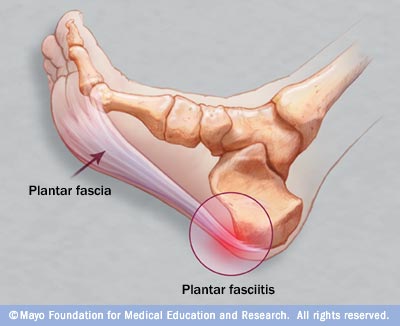Heel pain and stiffness? It may be plantar fasciitis
Plantar fasciitis is a condition that affects runners and is also common in overweight individuals and in people who wear shoes with inadequate support. It’s a common issue that affects 1 in 10 people and is present in men and women alike. Treatable and preventable, plantar fasciitis is not a severe condition, but it can be annoying and can prevent one from engaging in various activities, such as running or even walking for long distances.
One of the most common causes of heel pain, plantar fasciitis is caused by the inflammation of the plantar fascia, a band of thick tissue that runs across the bottom of the feet, connecting the toes with the heel bone.
This band of tissue supports the arch of your foot, so when it gets inflamed, it becomes weak, irritated, swollen and painful. The pain can be located around the heel or the bottom of your foot, and is described as stabbing pain that typically occurs when you take the first steps in the morning. However it can also return during the day, when you walk or stand for several hours or when you get up from a seated position.
Plantar fasciitis can affect people of all ages but is more common in young and middle-aged people, and is more likely to affect athletes, soldiers or individuals whose jobs involve a lot of sitting or standing.
What causes plantar fasciitis?
As said, the plantar fascia supports the arch of the foot and it acts like a shock-absorbing bowstring, so when the load or tension in this band of tissue becomes too great, it can cause the tearing and stretching of the fascia, leading to inflammation. Repeated strain and small injuries of the plantar fascia can also lead to the swelling and irritation of the tissue and cause the specific pain.
Plantar fasciitis is more likely to occur in people with flat feet or high arches, in those who are overweight, in individuals with tight calf muscles or Achilles tendons, in those who walk for long periods of time or run on hard surfaces, as well as in people with excessive pronantion when walking (rolling your feet inward too much). If you’re an athlete and recently started exercising on a different surface, you may also experience this type of pain.
Maintaining a healthy weight, running with supportive shoes, increasing your exercise level gradually and alternating running with other forms of physical activity to prevent the tearing of the plantar fascia, stretching the Achilles tendon and in general taking care of your feel by wearing adequate shoes that offer proper support for your aches are efficient preventive measures.
How is plantar fasciitis treated?
The best form of treatment is stretching and exercise. Regular, gentle stretching of the Achilles tendon and plantar fascia should be enough for easing the symptoms, but in case the pain persists or gets worse, there are other solutions available. First, rest your feet and try to keep weight off the painful foot at least until the inflammation goes away.
Applying ice packs on the swollen and irritated tissue for 10-20 minutes may help, so repeat 2-3 times a day, or as needed. If the inflammation doesn’t go away and your job requires you to stand or walk a lot, your doctor may also prescribe some non-steroidal anti-inflammatory medication.
To minimize the risk of recurrence it’s recommended to apply these remedies when you first notice the symptoms. Avoid running or walking on hard surfaces until the inflammation goes away, and apply an anti-inflammatory cream on the painful area before sleep, massaging the tissue.
Wear shoes that offer proper support and good shock absorption, such as athletic shoes with cushioned soles. If needed, use a shoe insert until the pain goes away. Avoid going barefoot or wearing slippers or other types of shoes with flat soles, as these may make the pain worse.
You can also try whole body vibration exercises, as they’re good for increasing circulation and muscle flexibility, and at lower frequencies are good for stretching the painful muscles. You can do heel raises and calf stretches, or simply stand on the machine and enjoy a relaxing massage.
Have other suggestions? Comment below or join our Facebook community and share your thoughts with us!








